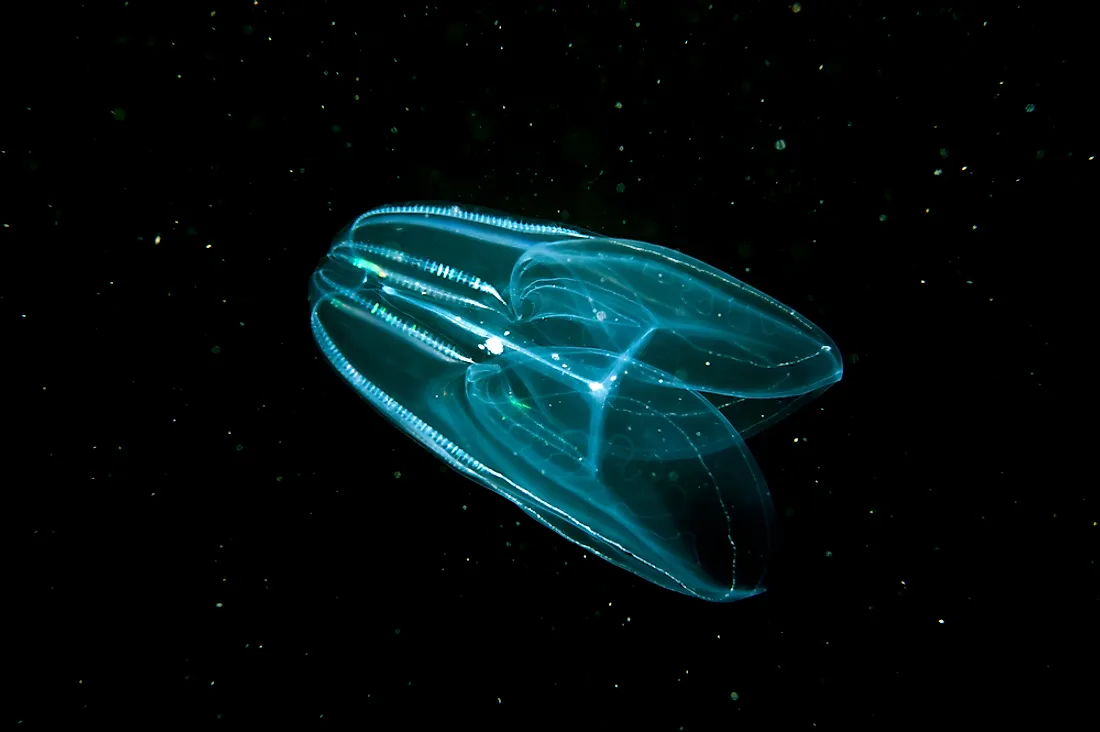Comb Jellies — Animals of the Oceans

Comb jellies (Ctenophora) belong to a phylum of invertebrates inhabiting marine waters worldwide. The name comb jelly is derived from the plates of giant fused cilia which run in rows up and down their bodies. Comb jellies are the largest creatures that use cilia to aid in movement. Comb jellies live in different marine environments across the world.
Description
Comb jellies have a soft, transparent, and gelatinous body made up of a mass of jelly. Their bodies comprise of two layers of cells on the outside and a lining in the inner cavity. The creatures measure from 4 feet to 11 feet in length. There are two 50 foot-long tentacles extending from the sheath near the aboral end that are filled with colloblasts and cilia. Comb jellies are bioluminescent and they possess protein tissues that undergo chemical reactions to produce blue or green light in response to bright light. In addition, they have a statocyst located in the aboral end which aids in balance. If a comb jelly is tilting backwards, statolith and neural signals help to tilt the comb jelly up to its normal position by distinctively whipping the comb rows. Most species of the comb jellies have an oval shape with a mouth on one end and anal pores on the other end.
Habitat and Distribution
Combo jellies live in a variety of marine waters worldwide. They are adapted to tolerate a wide range of conditions in reference to temperatures, oxygen levels, salinity, and general water quality. They are mainly found in larger numbers in the shallow waters of estuaries and bays of the Pacific Ocean. Oddly enough, ocean sprawl by humans in the form of docks, oil-drilling platforms, and underwater constructions provide ample breeding grounds for comb jellies. Due to their ability to survive in different water environments, they have invaded the Caspian, Black, and Baltic seas. As of 2013, they were listed among the world’s worst invasive alien species by the Global Invasive Species Program.
Reproduction
Comb jellies are hermaphroditic, meaning both sexes are found in the same individual. They release the eggs and sperm in water through the mouth on a daily basis to increase the chances of fertilization. The sperm and eggs drift with the waves until each gamete finds the other. The fertilized egg develops into a larva that resembles small adult ctenophore. If the combo jellies run out of food while reproducing, they shrink and squat on the ocean floor until they run into more food and start reproducing again.
Diet
Ctenophores are mainly predators that feed on platonic animals, crustaceans, fish larvae, and other ctenophores. They usually incorporate their prey’s cells into their own tentacles instead of stinging them. Different species of comb jellies use different techniques, similar to spiders capturing their prey. The most identified techniques encompass hanging motionless in the water and using their tentacles as webs, excreting a sticky droplet from the colloblasts and placing it at the end of a fine thread, and ambushing their prey. Their digestive tract comprises a complex series of canals running along the periphery to the central digestive canal. Comb jellies excrete through the mouth or anal pores.











